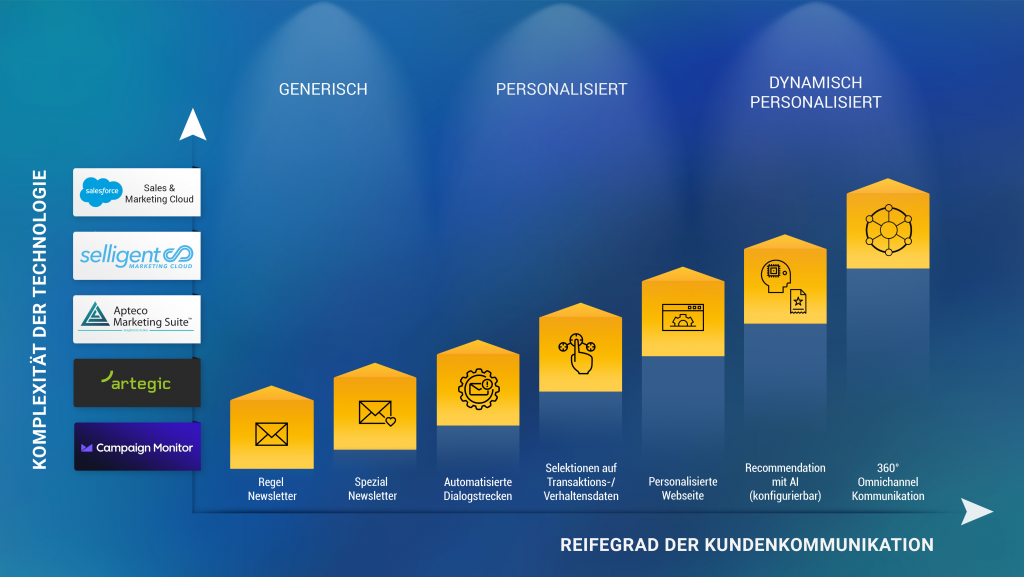“We need a new mail and automation technology” or “We want to run highly personalized multi-channel marketing in the future” – these are ambitions that we often hear and have sprung somewhere from the sales brochure of a large marketing cloudEine Marketing Cloud Technologie umfasst verschiedene Module für die aktive Bewirtschaftung und Dialogführung von Kunden über eine digitale Marketing Plattform, welche selbst als SaaS-Dienstleistung - also über das Internet und nicht proprietär im eigenen... solution. Unfortunately, this costs a six-figure sum in annual licenses and a multiple of the implementation effort, and it is worth thinking about the return on investment.
Euphoria is quickly caught up with financial reality and lack of human resources, and for large companies it sometimes takes a little longer to deploy the technology, for example. So what is the customer supposed to do with it now? The technology does not deliver an out-of-the-box strategy?

It is this simple homework that the customer must first clarify before deciding on a new technology:
- The culture and level of digital transformation in their own company, the business decision, the support from the very top and the associated change process,
- the objective and the importance of communication and customer interaction via digital channels,
- budget, i.e. pure cost view vs. performance, i.e. return on investment that really counts,
- scalability and thus a content roadmap over the following 2-4 years,
- the company’s own employees, who should also implement the marketing strategy, and their skills,
- a network of internal and external specialists, with whom one wants to build up a long-term cooperation, which is characterized by trust and goals, less by permanent cost pressure.
And it’s worth talking not just to a software vendor’s sales department, but to specialists who are able to develop use cases, assess the pros and cons of technologies, and set up a digital marketing project for the long term.
Efficient email marketing:
The roadmap of the marketing clouds usually starts with the normal e-mail dispatch. However, if you have not yet attached much importance to a growing and well-maintained email recipient list, you should not shoot at sparrows with cannons. In the beginning there was the list of recipients, and this list builds up over the years in painstaking work. If you have fewer than 10,000 addresses and simply want to send out a regular newsletter, you don’t need a complex omnichannel solution. MalChimp, Campaign Monitor (see graphic), CleverReach or NewsletterToGo, to name the most important players, are sufficient. They even include standardized automated processes such as confirmation mails, welcome mails or birthday greetings. With setup costs of CHF 5000 and an annual license of CHF 100-3000, you are in and reaching your target group. Can this already be called marketing?
Email and automation for advanced users:
Who is concerned about the quality of mail delivery at the most important ISPs, who does not want to have his data in the no man’s land of data protection, i.e. on non-European servers, who wants to fill more complicated data fields than just the date of birth for trigger mails in the future, who cares about target group selections for a relevant address, for whom campaign control or cadence management plays a role, who has somewhat more complicated data interfaces to ERP, CRM and/or eShop, who is thinking about marketing solutions that allow them better flexibility and scalability.
The approach to the decision to switch to solutions in the direction of an increased maturity level of digital communication runs through use cases: transactional mails, regular newsletters, target group selections, trigger mails, life cycle communication across multiple touchpoints, dynamic personalization of content, automation of mail stacks are the buzzwords. It is worthwhile to work out this groundwork with external specialists. With prioritization and a binding roadmap over the next few years, the result is the evaluation of mid-market software solutions such as ELAINE (see graphic), Inxmail or mapp. Before using this software, a clear performance or customer retention strategy should already be in place. The regular involvement of a service agency is also worthwhile in order to further develop or slowly automate the customer dialog. However, the ambitions usually end here as well, no full data integration and multi-channel control. The setup costs are from CHF 10,000, the annual license is usually no longer volume-based, but calculated on the number of maintained (customer) contacts and starts at about CHF 4000.
The top maturity level, data-driven and controlled via various channels.
The marketing clouds of international providers such as Salesforce or Selligent (see graphic), Adobe, Oracle are a serious investment in the digitization of customer relationships and comprehensive marketing via digital channels. They are worthwhile for (at least) several hundred thousand recipients and the declared goal of creating regular selections, controlling these via targeted management, and largely automating the processes; not only via the e-mail channel, but also via paid media, social channels, call centers, or direct mails, depending on the recipient’s accessibility. The selections result from the CRM or a high-performance data analytics tool (such as Apteco, see graphic), which is connected directly or via an interface. Data cleansing and merging as well as established interfaces to the most important surrounding systems are a must. Marketing clouds are increasingly making use of algorithms from the findings of “machine learning”, which are based not only on customer purchase data, but also on behavioral data from website, newsletter and store visits; this allows content to be personalized for target groups, at a manageable cost in the data analytics environment.
In such projects, the setup alone can take several months. Work is done in phases. A roadmap for strategy, the data cleansing that often accompanies it, and the detailed technical implementation are documented. Vendors, implementation agencies and in-house staff work closely together. And as mentioned, “out-of-the-box” is nothing. The customer must understand the opportunities offered by the marketing cloud, want to use it in the long term, and provide dedicated in-house staff. The focus is on performance, not costs: the legitimacy must result from significant revenue growth, for example in an eShop, or from cost savings thanks to automation and/or the possibility of reaching the end customer via multiple channels and touchpoints thanks to a 360° view of the end customer. In the case of international groups, the uniform technology and parallel roll-out in different countries is of course an important argument. Initial costs easily exceed CHF 100,000, further project costs are open to the top, licenses are also quickly in the six-figure range with maintained contacts between 500K and one million. And further development requires regular support, both internally and externally, in order to fully exploit the technology and come closer to the famous “customer centricity”.
From quick wins to relevant use cases and campaign management:
Tip: Recognize the strategic importance, but start with simple projects and quick wins and a few channels, possibly a proof of concept, clean up the necessary data in parallel to be able to use it optimally in the medium term. Useful use cases increase by leaps and bounds with a good understanding of data. The path via a high-performance data analysis tool such as Apteco may be worthwhile. It allows the playful handling of data logs and customer segments in order to be able to test hypotheses for new target groups and projects before they are directly handed over to a campaign control. And from there, the end customers are addressed over time via the various digital channels.
Already some marketing cloudEine Marketing Cloud Technologie umfasst verschiedene Module für die aktive Bewirtschaftung und Dialogführung von Kunden über eine digitale Marketing Plattform, welche selbst als SaaS-Dienstleistung - also über das Internet und nicht proprietär im eigenen... projects have started with high expectations and ambitious management and failed due to the lack of understanding, the complexity of the possibilities and the lack of resources; and end up back with MailChimp or at least a downsizing of the demands. This is not a bad thing per se, but the detour would often not be necessary if the business objective and homework were done correctly at the start. However, those who do not dare to make the leap to the marketing cloudEine Marketing Cloud Technologie umfasst verschiedene Module für die aktive Bewirtschaftung und Dialogführung von Kunden über eine digitale Marketing Plattform, welche selbst als SaaS-Dienstleistung - also über das Internet und nicht proprietär im eigenen... may one day be left behind by international competitors or disruptive game changers who have long since completed the important change process (or never even had to do so) and benefit greatly from economies of scale.

